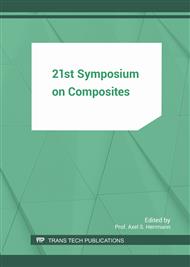[1]
T. Srivatsan, M. Al-Hajri, M. Petraroli, B. Hotton, P. Lam, Influence of silicon carbide particulate reinforcement on quasi static and cyclic fatigue fracture behavior of 6061 aluminum alloy composites, Materials Science and Engineering: A 325 (2002).
DOI: 10.1016/s0921-5093(01)01444-7
Google Scholar
[2]
C. Kaynak, S. Boylu, Effects of SiC particulates on the fatigue behaviour of an Al-alloy matrix composite, Materials & Design 27 (2006) 776–782.
DOI: 10.1016/j.matdes.2005.01.009
Google Scholar
[3]
N. Chawla, C. Andres, L.C. Davis, J.W. Jones, J.E. Allison, The interactive role of inclusions and SiC reinforcement on the high-cycle fatigue resistance of particle reinforced metal matrix composites, Metall and Mat Trans A 31 (2000) 951–957.
DOI: 10.1007/s11661-000-1013-2
Google Scholar
[4]
Y. Sugimura, S. Suresh, Effects of sic content on fatigue crack growth in, Metallurgical Transactions A 23A (1992) 2231–2242.
DOI: 10.1007/bf02646016
Google Scholar
[5]
N. Chawla, C. Andres, J.W. Jones, J.E. Allison, Effect of SiC Volume Fraction and Particle Size on the Fatigue Resistance of a 2080 Al/SiCp Composite, Metallurgical and Materials Transactions A 29 (1998) 2843–2854.
DOI: 10.1007/s11661-998-0325-5
Google Scholar
[6]
J.N. Hall, J. Wayne Jones, A.K. Sachdev, Particle size, volume fraction and matrix strength effects on fatigue behavior and particle fracture in 2124 aluminum-SiCp composites, Materials Science and Engineering: A 183 (1994) 69–80.
DOI: 10.1016/0921-5093(94)90891-5
Google Scholar
[7]
D.P. Myriounis, S.T. Hasan, Fatigue Behaviour of Al/Al203 Metal Matrix Composites, Kazan, Russia, (2012).
Google Scholar
[8]
L. Chingshen, F. Ellyin, Fatigue damage and its localization in particulate metal matrix composites, Materials Science and Engineering: A 214 (1996) 115–121.
DOI: 10.1016/0921-5093(96)10250-1
Google Scholar
[9]
S.C. Tjong, G.S. Wang, Y. -. Mai, High cycle fatigue response of in-situ Al-based composites containing TiB2 and Al2O3 submicron particles, Composites Science and Technology 65 (2005) 1537–1546.
DOI: 10.1016/j.compscitech.2005.01.012
Google Scholar
[10]
B. Kieback, A. Neubrand, H. Riedel, Processing techniques for functionally graded materials, Materials Science and Engineering: A 362 (2003) 81–106.
DOI: 10.1016/s0921-5093(03)00578-1
Google Scholar
[11]
A. Bishop, C. -Y. Lin, M. Navaratnam, D. Rawlings, B. McShane, A functionally gradient material produced by a powder metallurgical process, Journal of Material Science Letters 12 (1993) 1516–1518.
DOI: 10.1007/bf00277083
Google Scholar
[12]
U. Birth, M. Joensson, B. Kieback, Powder Metallurgical Processing and Properties of Copper/Tungsten Gradients, MSF 308-311 (1999) 766–773.
DOI: 10.4028/www.scientific.net/msf.308-311.766
Google Scholar
[13]
E. Foroozmehr, R. Saraffi, S. Hamid, R. Kovacevic, Synthesizing of Functionally Graded Surface Composites by Laser Powder Deposition Process for Slurry Erosion Applications, in: F.J. Fabozzi, V. Kothari (Eds. ), Introduction to Securitization, John Wiley & Sons, Inc, Hoboken, NJ, USA, 2008, p.1.
Google Scholar
[14]
O. Eso, Z. Fang, A. Griffo, Liquid phase sintering of functionally graded WC–Co composites, International Journal of Refractory Metals and Hard Materials 23 (2005) 233–241.
DOI: 10.1016/j.ijrmhm.2005.04.017
Google Scholar
[15]
J.F. Groves, H. Wadley, Functionally graded materials synthesis via low vacuum directed vapor deposition, Composites Part B: Engineering 28 (1997) 57–69.
DOI: 10.1016/s1359-8368(96)00023-6
Google Scholar
[16]
A. Mortensen, S. Suresh, Functionally graded metals and metal-ceramic composites: Part 1 Processing, International Materials Review 40 (1995) 239–265.
DOI: 10.1179/imr.1995.40.6.239
Google Scholar
[17]
H. Gutzmann, S. Fresse, F. Gärtner, T. Klassen, Cold Gas Spreaying of ceramics using the example of titanium dioxide, in: DVS Media GmbH (Ed. ), ITSC 2011: International Thermal Spray Conference & Exposition; abstracts (including manuscripts on CD-ROM) of the conference in Hamburg on September 27 - 29, 2011 in the context of DVS Congress and DVS Expo, DVS Media, Düsseldorf, 2011, p.391.
DOI: 10.31399/asm.cp.itsc2011p0369
Google Scholar
[18]
I. Ozdemir, K. Ogawa, K. Sato, D. Seo, iron boride coatings produced by cold spray processes, in: DVS Media GmbH (Ed. ), ITSC 2011: International Thermal Spray Conference & Exposition; abstracts (including manuscripts on CD-ROM) of the conference in Hamburg on September 27 - 29, 2011 in the context of DVS Congress and DVS Expo, DVS Media, Düsseldorf, 2011, p.1096.
DOI: 10.31399/asm.cp.itsc2011p1074
Google Scholar
[19]
R. Jendrzejewski, K. van Acker, D. Vanhoyweghen, G. Śliwiński, Metal matrix composite production by means of laser dispersing of SiC and WC powder in Al alloy, Applied Surface Science 255 (2009) 5584–5587.
DOI: 10.1016/j.apsusc.2008.09.048
Google Scholar
[20]
Ö. Savaş, R. Kayikci, F. Ficici, S. Köksal, Production of Functionally Graded AlB2/Al-4%Mg Composite by Centrifugal Casting, PEN 1 (2013).
DOI: 10.21533/pen.v1i2.23
Google Scholar
[21]
Y. Watanabe, A. Kawamoto, K. Matsuda, Particle size distributions in functionally graded materials fabricated by the centrifugal solid-particle method, Composites Science and Technology 62 (2002) 881–888.
DOI: 10.1016/s0266-3538(02)00023-4
Google Scholar
[22]
Y. Watanabe, N. Yamanaka, Y. Fukui, Control of composition gradient in a metal-ceramic functionally graded material manufactured by the centrifugal method, Composites Part A: Applied Science and Manufacturing 29 (1998) 595–601.
DOI: 10.1016/s1359-835x(97)00121-8
Google Scholar
[23]
M. Ando, H. Kitano, H. Usami, T. Endo, Applicability of fine particle peening on surface modification of aluminum alloy 223–227.
Google Scholar
[24]
H. Ishibashi, H. Tobimatsu, K. Hayashi, T. Matsumoto, A.P. Tomsia, E. Saiz, Characterization of Mo-SiO2 functionally graded materials, Metall and Mat Trans A 31 (2000) 299–308.
DOI: 10.1007/s11661-000-0074-6
Google Scholar
[25]
N. Chawla, Y. -L. Shen, Mechanical Behavior of Particle Reinforced Metal Matrix Composites, Adv. Eng. Mater. 3 (2001) 357–370.
DOI: 10.1002/1527-2648(200106)3:6<357::aid-adem357>3.0.co;2-i
Google Scholar
[26]
V. Schulze, J. Hoffmeister, M. Klemenz, Correlation of Mechanical Surface Treatments, induced Surface States and Fatigue Performance of Steel Components, Procedia Engineering 19 (2011) 324–330.
DOI: 10.1016/j.proeng.2011.11.120
Google Scholar
[27]
B. Scholtes, O. Vöhringer, Ursachen, Ermittlung und Bewertung von Randschichtveränderungen durch Kugelstrahlen, Mat. -wiss. u. Werkstofftech. 24 (1993) 421–431.
DOI: 10.1002/mawe.19930241206
Google Scholar
[28]
H. Wohlfahrt (Ed. ), Mechanische Oberflächenbehandlungen: Grundlagen, Bauteileigenschaften, Anwendungen, Wiley-VCH, Weinheim, (2000).
Google Scholar


